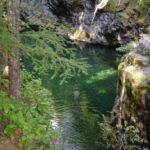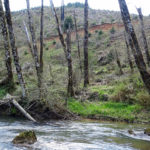Protecting Salmon with Thermal Refuge from Hot River Temperatures
NWEA Forces Regulatory Agencies to Address Salmon Needs
Hot water stresses and kills cold-water fish such as salmon, steelhead, and bull trout. The concept of providi
The Agencies Rely on the Thermal Refuge Concept to Meet the Clean Water Act
Some rivers, such as the Columbia and Willamette mainstems, are believed to have historically been too hot for salmon migrating in summer temperatures. It has been assumed that these salmon survived warm river temperatures by moving from one thermal refuge to another. Such refuges could be provided by the input of a cooler tributary, an influx of cold groundwater, or hyporheic flow (a place in the streambed where groundwater and surface water mix). For this reason, in 2003, following NWEA’s first successful lawsuit challenging Oregon’s unprotective water quality standards for temperature, the U.S. Environmental Protection Agency (EPA) Region 10 instructed Northwest states that they could adopt a too-hot 20°C (68°F) numeric criterion to protect migrating salmon so long as the states also provided sufficient cold water refuges for those salmon. Oregon was ordered to adopted new standards, which included this critical protection, and EPA approved them in 2004.
The Agencies Do Nothing to Actually Provide Thermal Refuges for Salmon
In NWEA’s second lawsuit challenging EPA’s approval of Oregon’s temperature standards, we won a 2012 court order to fix the defective evaluation conducted by the federal agencies under the Endangered Species Act. As a result, in 2015, the National Marine Fisheries Service (NMFS) issued a new Biological Opinion evaluating the temperature standards. NMFS found exactly what we predicted: the Oregon Department of Environmental Quality (DEQ) had paid only lip service to the thermal refuge requirement and the EPA had ignored the state’s failure. EPA had told NMFS that it expected the thermal refuges would be identified in the development of Total Maximum Daily Loads (TMDL), science-based clean-up plans required by the Clean Water Act, as well as in NPDES discharge permits.
Nothing like that had happened. By this point, Oregon DEQ had issued numerous temperature TMDLs under a court order in another NWEA lawsuit, which allowed NMFS to see what had actually taken place, rather than to just rely on EPA and Oregon promises. The TMDLs demonstrated that Oregon DEQ had failed to identify thermal refuges, had failed to evaluate whether there were sufficient thermal refuges, and had provided no protection for any thermal refuges. In other words, the passage of time 
As a consequence, NMFS required EPA and DEQ to develop Cold Water Refugia Plans for the Columbia and Willamette Rivers that would assess whether sufficient refuges exist, what more is needed, and to “identify and prioritize potential actions needed to protect, restore or enhance” the refuges. The agencies were given three years to complete this process. Due in November 2018, neither EPA and DEQ has produced their plans.
As for EPA and Oregon DEQ’s promise to address the need for cold water refuges in NPDES discharger permits? Another epic fail. Instead, or using permits to protect thermal refuges, Oregon DEQ decided to do the opposite and allow cities and towns to discharge treated sewage into rivers’ hyporheic zones. In 2013, NWEA pointed out the fallacy of this approach to EPA and we believe that it has come to a halt.
NWEA Highlights Oregon’s Failure to Control Agricultural Pollution
With Oregon staring down a November 15, 2013 date on which two federal agencies must issue a proposed decision on the State’s coastal nonpoint pollution program, NWEA’s more recent letter describes Oregon’s nonpoint program failure to control agricultural pollution....
Federal Court Vacates Oregon’s Water Quality Temperature Standards
Over a year after a federal court ruled in NWEA’s favor on key provisions of Oregon's water quality temperature standards, an agreement between NWEA and EPA has resulted in two court orders – one in January and the second in April – in which the court has vacated the...
Oregon cheating on water quality trading program
Pollution credit trading is a new idea that is already badly tarnished. Many examples of abuses exist, including an increase in production of dangerous gases in response to a United Nations climate change credit initiative. In the Pacific Northwest pollution credit...
